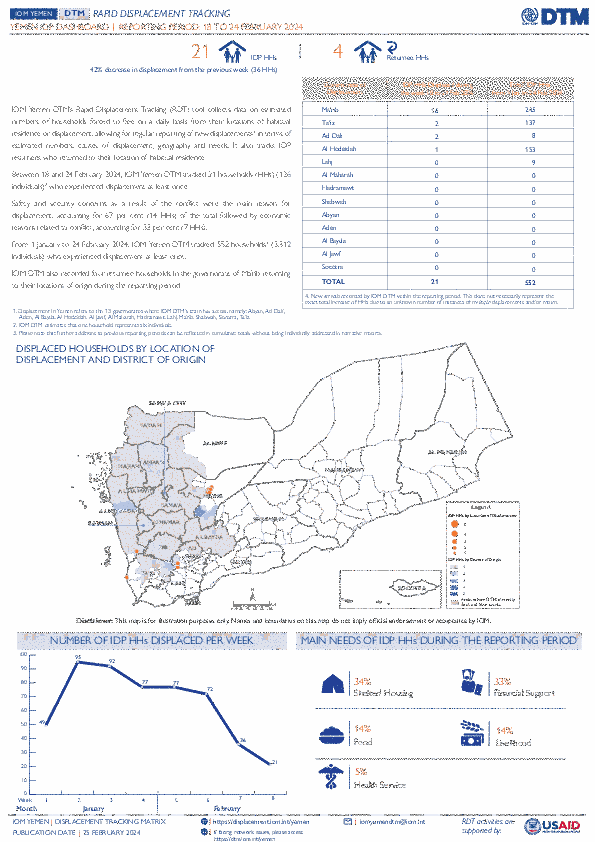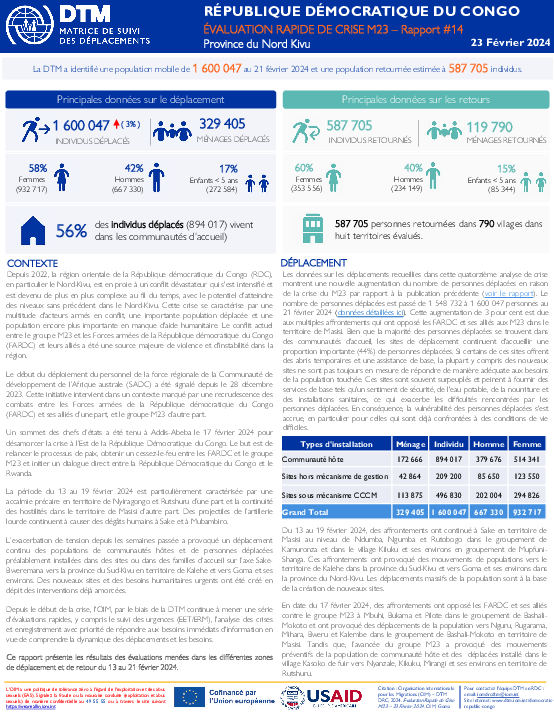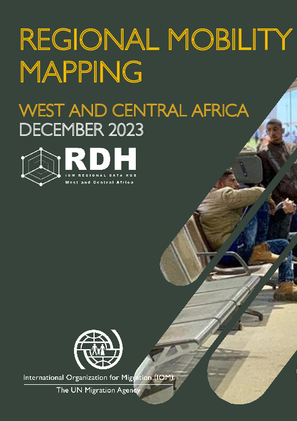-
Countries
-
Data and Analysis
-
Special Focus
-
Crisis Responses

Contact
DTM Yemen, iomyemendtm@iom.int
Language
English
Location
Yemen
Period Covered
Feb 18 2024
Feb 24 2024
Activity
- Mobility Tracking
- Event Tracking
IOM Yemen DTM’s Rapid Displacement Tracking (RDT) tool collects data on estimated numbers of households forced to flee on a daily basis from their locations of origin or displacement, allowing for regular reporting of new displacements in terms of estimated numbers, geography, and needs. It also tracks returnees who returned to their location of origin.
From 1 January to 24 February 2024, IOM Yemen DTM tracked 552 households (HH) (3,312 Individuals) who experienced displacement at least once.
Between 18 and 24 February 2024, IOM Yemen DTM tracked 21 households (126 individuals) displaced at least once. The majority of people moved into/within the following governorates and districts:
- Ma’rib (16 HHs) – Ma’rib City (13 HHs), Ma’rib (3 HHs) districts. Most displacements in the governorate originated from Ma’rib and Al Hodeidah.
- Ad Dali (2 HHs) – Al Azariq (2 HHs) district. All displacements in the governorate originated from Ad Dali and Ta’iz.
- Ta’iz (2 HHs) – Al Makha (2 HHs) district. All displacements in the governorate were internal.
The majority of people moved from the following governorates and districts:
- Ma’rib (5 HHs) – Rahabah (3 HHs), Harib (2 HHs) districts.
- Ta’iz (5 HHs) – Mawiyah (2 HHs), Al Mudhaffar (1 HH), At Taiziyah (1 HH) districts.
- Al Hodeidah (5 HHs) – Bajil (2 HHs), Al Hali (1 HH), Jabal Ras (1 HH) districts.
IOM identified 35 households displaced in the previous reporting period, which covered 11 - 17 February 2024, in the governorates of Ta’iz (14 HHs), Ma’rib (12 HHs), and Al Hodeidah (9 HHs). These figures have been added to the cumulative displacement total recorded since the beginning of the year.
Contact
DTM Yemen, iomyemendtm@iom.int
Location
Yemen
Activity
- Mobility Tracking
- Event Tracking
Period Covered
Feb 18 2024 -Feb 24 2024
From 1 January to 24 February 2024, IOM Yemen DTM tracked 552 households (HH) (3,312 Individuals) who experienced displacement at least once.
Between 18 and 24 February 2024, IOM Yemen DTM tracked 21 households (126 individuals) displaced at least once. The majority of people moved into/within the following governorates and districts:
- Ma’rib (16 HHs) – Ma’rib City (13 HHs), Ma’rib (3 HHs) districts. Most displacements in the governorate originated from Ma’rib and Al Hodeidah.
- Ad Dali (2 HHs) – Al Azariq (2 HHs) district. All displacements in the governorate originated from Ad Dali and Ta’iz.
- Ta’iz (2 HHs) – Al Makha (2 HHs) district. All displacements in the governorate were internal.
The majority of people moved from the following governorates and districts:
- Ma’rib (5 HHs) – Rahabah (3 HHs), Harib (2 HHs) districts.
- Ta’iz (5 HHs) – Mawiyah (2 HHs), Al Mudhaffar (1 HH), At Taiziyah (1 HH) districts.
- Al Hodeidah (5 HHs) – Bajil (2 HHs), Al Hali (1 HH), Jabal Ras (1 HH) districts.
Population Groups
Survey Methodology
Unit of Analysis Or Observation
Type of Survey or Assessment
Keywords
Geographical Scope
Administrative boundaries with available data
The current dataset covers the following administrative boundaries
Between 22 December 2023 to 21 February 2024, sporadic attacks and fear of attacks by Non-state Armed Groups in Macomia, Chiure, Mecufi, Mocimboa da Praia, and Muidumbe triggered the cumulative displacement 64,941 individuals/13,935 families. [For more see Emergency Tracking Online Dashboard]. The current Movement Alert #100 reports on recent attacks recorded in Macomia, Chiure and Mecufi between 8 to 22 February that displaced 51,376 individuals.
Contact
DTM Niger, NigerDataResearch@iom.int
Location
Niger
Activity
- Mobility Tracking
- Baseline Assessment
- Village Assessment
Period Covered
Nov 18 2023 -Dec 28 2023
In Round 7, 378 868 IDP individuals and 74 358 IDP households, 163 611 returnees and 24 429 returnee households were identified.
Population Groups
IDPs
Returnee (Previously Internally Displaced)
Survey Methodology
Unit of Analysis Or Observation
Admin Area 2
Admin Area 3
Admin Area 4
Site or Location
Type of Survey or Assessment
Key Informant
Keywords
Geographical Scope Partial Coverage
Administrative boundaries with available data
The current dataset covers the following administrative boundaries

Contact
DTMUkraine@iom.int
Language
English
Location
Ukraine
Period Covered
Jan 02 2024
Jan 11 2024
Activity
- Mobility Tracking
У цьому звіті визначено системи опалення, що використовуються в українських домогосподарствах, представлено орієнтовні ціни на тверде паливо в різних областях, а також проаналізовано методи та частоту закупівлі твердого палива населенням України. Звіт досліджує поточний та майбутній попит, пропозицію та ціни на основні види твердого палива. Основна мета - підтримати поточні гуманітарні операції з підготовки до зими.
У період з 2 по 11 січня 2024 року команда Відділ даних та аналітики дослідив 287 ринків у 23 областях України та місті Києві, методом проводення особистих та дистанційних інтерв'ю як з місцевими продавцями, так і з координаторами громад. У кожній області дані збиралися щонайменше у двох місцях - у міській та сільській місцевостях та/або у прифронтовій зоні, де це було можливо. У кожному населеному пункті було опитано щонайменше двох постачальників та двох контактних осіб. Контактні особи було обрано на основі їх обізнаності з предметом дослідження та знань про підготовку до зими на рівні громади.
The development and implementation of policies and programmes in West and Central Africa promoting safe, orderly and humane migration require a better understanding of human mobility in the region.
Human mobility in the region take many different forms. Transhumance, seasonal migration conducted during the harvesting season, travel during religious festivities, tourism, economic migration to North Africa and Europe, the search for employment in the mining industry, forced displacements due to conflict, natural disasters or climate-related migration, rural exodus, are all examples of movements observes in West and Central Africa and show the many faceted nature of mobility in the region.
This document is an attempt to provide a dynamic and regularly updated portrait of mobility within, from and to West and Central Africa regionon for Migration (IOM), the United Nations Department of Economic and Social Affairs (UNDESA) and the United Nations High Commissioner for Refugees (UNHCR).

Contact
DTM DRC, iomdrcdtm@iom.int
Language
French
Location
Democratic Republic of the Congo
Period Covered
Feb 13 2024
Feb 21 2024
Activity
- Mobility Tracking
- Event Tracking
Depuis 2022, la région orientale de la République démocratique du Congo (RDC), en particulier le Nord-Kivu, est en proie à un conflit dévastateur qui s'est intensifié et est devenu de plus en plus complexe au fil du temps, avec le potentiel d'atteindre des niveaux sans précédent dans le Nord-Kivu. Cette crise se caractérise par une multitude d'acteurs armés en conflit, une importante population déplacée et une population encore plus importante en manque d'aide humanitaire. Le conflit actuel entre le groupe M23 et les Forces armées de la République démocratique du Congo (FARDC) et leurs alliés a été une source majeure de violence et d'instabilité dans la région.
Le début du déploiement du personnel de la force régionale de la Communauté de développement de l’Afrique australe (SADC) a été signalé depuis le 28 décembre 2023. Cette initiative intervient dans un contexte marqué par une recrudescence des combats entre les Forces armées de la République démocratique du Congo (FARDC) et ses alliés d’une part, et le groupe M23 d’autre part. L’exacerbation de tension depuis les semaines passée a provoqué un déplacement continu des populations de communautés hôtes et de personnes déplacées préalablement installées dans des sites ou dans des familles d’accueil sur l’axe Sake-Bweremana vers la province du Sud-Kivu en territoire de Kalehe et vers Goma et ses environs. Des nouveaux sites et des besoins humanitaires urgents ont été créé en dépit des interventions déjà amorcées.
Depuis le début de la crise, l'OIM, par le biais de la DTM continue à mener une série d'évaluations rapides, y compris le suivi des urgences (EET/ERM), l'analyse des crises et enregistrement avec priorité de répondre aux besoins immédiats d'information en vue de comprendre la dynamique des déplacements et les besoins. Ce rapport présente les résultats des évaluations menées dans les différentes zones de déplacement et de retour du 13 au 21 février 2024.

Contact
DTM DRC, iomdrcdtm@iom.int
Language
English
Location
Democratic Republic of the Congo
Period Covered
Feb 13 2024
Feb 21 2024
Activity
- Mobility Tracking
- Event Tracking
Since 2022, the eastern region of the Democratic Republic of Congo (DRC), in particular North Kivu, has been gripped by a devastating conflict that has intensified and become increasingly complex over time, with the potential to reach unprecedented levels in the province. This crisis is characterised by an abundance of armed actors in the conflict, a large-scale displacement and an increasing number of population in need of humanitarian aid. The ongoing conflict between the M23 group and the Forces Armées de la République démocratique du Congo (FARDC) and their allies has been a major source of violence and instability in the region. The start of the deployment of the Southern African Development Community (SADC) regional force has been announced for 28 December 2023. This initiative comes as a response to renewed fighting between the FARDC and its allies on the one hand, and the M23 group on the other.
The period from 13 to 19 February 2024 was particularly characterised by a precarious lull in the territory of Nyiragongo and Rutshuru on the one hand and the continuation of hostilities in the territory of Masisi on the other. Heavy artillery projectiles continue to cause human damage in Sake and Mubambiro. Since the beginning of the crisis, IOM, through its Displacement Tracking Matrix (DTM), has continued conducting a series of rapid assessments, including emergency monitoring (EET/ERM), crisis analysis and registration with the aim of responding to immediate information needs in order to understand displacement dynamics.
This report presents the results of assessments carried out in the various displacement and return areas between 13 and 21 February 2024.

Contact
DTM Nigeria, iomnigeriadtm@iom.int
Language
English
Location
Nigeria
Period Covered
Jan 01 2024
Feb 20 2024
Activity
- Mobility Tracking
- Event Tracking
Between 1 January and 20 February 2024, armed bandits carried out attacks on various communities Ampang ward, Kombul ward, Mangu ward and Mangu I ward in Plateau State. The specific communities affected include Bakin Kasuwa, Anguwan Sarki, Kofar Fada, Sabon Gari, Mairana, Mangu, Kinat, Kwahasalalek, Sabgoro, Matele, Dis, Panyam and Gangaran Kwata. The attacks affected 2,003 individuals and displaced them to communities of Nahuta, Banko, Unguwan Magaji, Gwaltukurwa, Lusa, Gajiwal and Kuletu in Dass LGA, Rimi Zayam, Anguwan Sarki, Sabon Gari, Nasarawa, Anguwan Rimi, Kawuli, Kara, Kassa B, Juwait, Kampawul and Rinji in Toro LGA, Boto, Anguwan Geate, Kofar Bai, Pans Sarki and Lere Primary School in Tafawa Balewa LGA and Liman Katagum in Bauchi LGA, all in Bauchi State. As a result of the attacks, 66 fatalities and 62 injuries were reported.

Contact
DTM Nigeria, iomnigeriadtm@iom.int
Language
English
Location
Nigeria
Period Covered
Jul 31 2023
Aug 06 2023
Activity
- Mobility Tracking
- Event Tracking
On 02 August, a land dispute erupted between the Mbakume (Mbaivur) and Mbasombo communities in Ikpayongo Town. The clash affected 156 individuals and displaced 155 individuals from Ikpayongo Town to Ichuwa IDP camp. As a result of the clash, one fatality and six injuries were reported.

